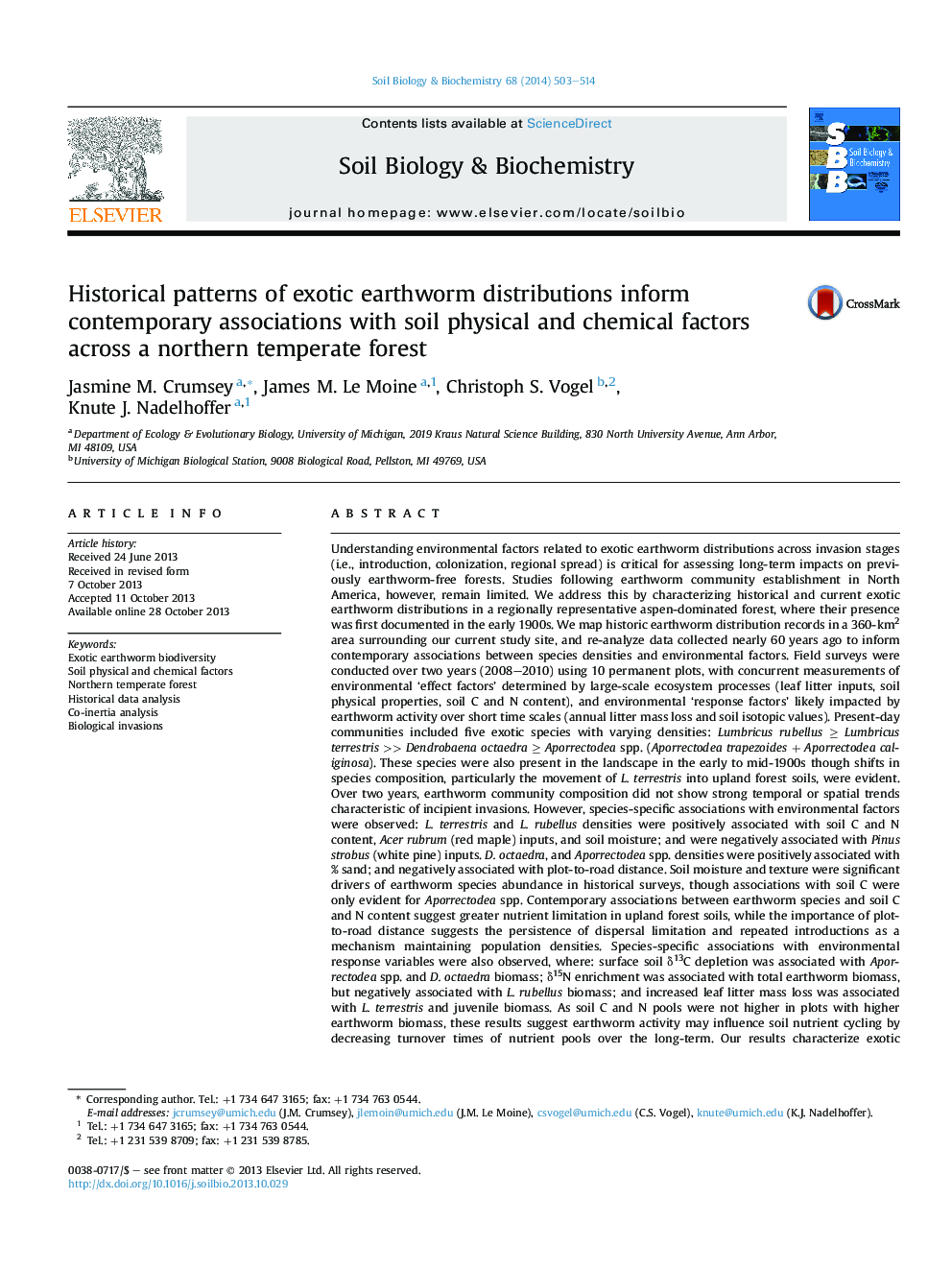| کد مقاله | کد نشریه | سال انتشار | مقاله انگلیسی | نسخه تمام متن |
|---|---|---|---|---|
| 8365187 | 1542616 | 2014 | 12 صفحه PDF | دانلود رایگان |
عنوان انگلیسی مقاله ISI
Historical patterns of exotic earthworm distributions inform contemporary associations with soil physical and chemical factors across a northern temperate forest
ترجمه فارسی عنوان
الگوهای تاریخی توده های کرم خاکی عجیب و غریب به ارتباطات معاصر با عوامل فیزیکی و شیمیایی خاک در یک جنگل معتدل شمالی اشاره می کنند
دانلود مقاله + سفارش ترجمه
دانلود مقاله ISI انگلیسی
رایگان برای ایرانیان
کلمات کلیدی
تنوع زیستی کرم خاکی عجیب و غریب، عوامل فیزیکی و شیمیایی خاک، جنگل معتدل شمالی تجزیه و تحلیل داده های تاریخی، تجزیه و تحلیل تلفیقی، حمله های بیولوژیکی،
موضوعات مرتبط
علوم زیستی و بیوفناوری
علوم کشاورزی و بیولوژیک
دانش خاک شناسی
چکیده انگلیسی
Understanding environmental factors related to exotic earthworm distributions across invasion stages (i.e., introduction, colonization, regional spread) is critical for assessing long-term impacts on previously earthworm-free forests. Studies following earthworm community establishment in North America, however, remain limited. We address this by characterizing historical and current exotic earthworm distributions in a regionally representative aspen-dominated forest, where their presence was first documented in the early 1900s. We map historic earthworm distribution records in a 360-km2 area surrounding our current study site, and re-analyze data collected nearly 60 years ago to inform contemporary associations between species densities and environmental factors. Field surveys were conducted over two years (2008-2010) using 10 permanent plots, with concurrent measurements of environmental 'effect factors' determined by large-scale ecosystem processes (leaf litter inputs, soil physical properties, soil C and N content), and environmental 'response factors' likely impacted by earthworm activity over short time scales (annual litter mass loss and soil isotopic values). Present-day communities included five exotic species with varying densities: Lumbricus rubellus â¥Â Lumbricus terrestris >> Dendrobaena octaedra â¥Â Aporrectodea spp. (Aporrectodea trapezoides + Aporrectodea caliginosa). These species were also present in the landscape in the early to mid-1900s though shifts in species composition, particularly the movement of L. terrestris into upland forest soils, were evident. Over two years, earthworm community composition did not show strong temporal or spatial trends characteristic of incipient invasions. However, species-specific associations with environmental factors were observed: L. terrestris and L. rubellus densities were positively associated with soil C and N content, Acer rubrum (red maple) inputs, and soil moisture; and were negatively associated with Pinus strobus (white pine) inputs. D. octaedra, and Aporrectodea spp. densities were positively associated with % sand; and negatively associated with plot-to-road distance. Soil moisture and texture were significant drivers of earthworm species abundance in historical surveys, though associations with soil C were only evident for Aporrectodea spp. Contemporary associations between earthworm species and soil C and N content suggest greater nutrient limitation in upland forest soils, while the importance of plot-to-road distance suggests the persistence of dispersal limitation and repeated introductions as a mechanism maintaining population densities. Species-specific associations with environmental response variables were also observed, where: surface soil δ13C depletion was associated with Aporrectodea spp. and D. octaedra biomass; δ15N enrichment was associated with total earthworm biomass, but negatively associated with L. rubellus biomass; and increased leaf litter mass loss was associated with L. terrestris and juvenile biomass. As soil C and N pools were not higher in plots with higher earthworm biomass, these results suggest earthworm activity may influence soil nutrient cycling by decreasing turnover times of nutrient pools over the long-term. Our results characterize exotic earthworm distributions at scales relevant to forest ecosystem processes, and allow for future extrapolation of laboratory and controlled field studies assessing impacts on soil nutrient cycling across northern temperate forests.
ناشر
Database: Elsevier - ScienceDirect (ساینس دایرکت)
Journal: Soil Biology and Biochemistry - Volume 68, January 2014, Pages 503-514
Journal: Soil Biology and Biochemistry - Volume 68, January 2014, Pages 503-514
نویسندگان
Jasmine M. Crumsey, James M. Le Moine, Christoph S. Vogel, Knute J. Nadelhoffer,
